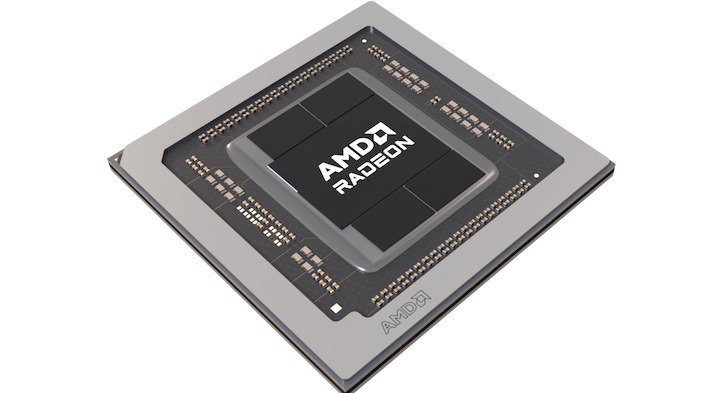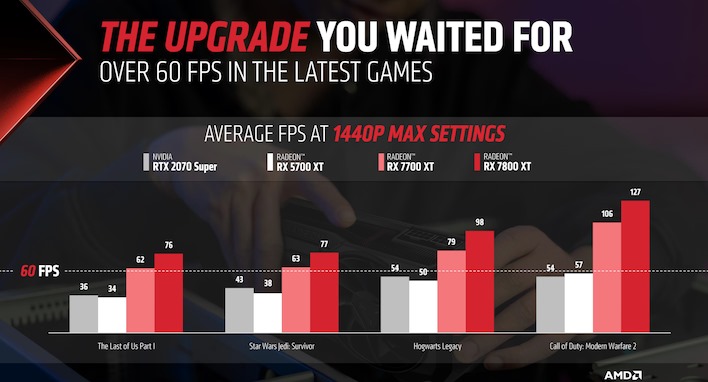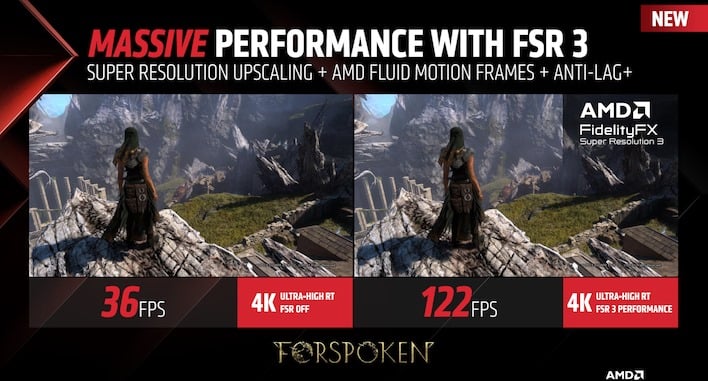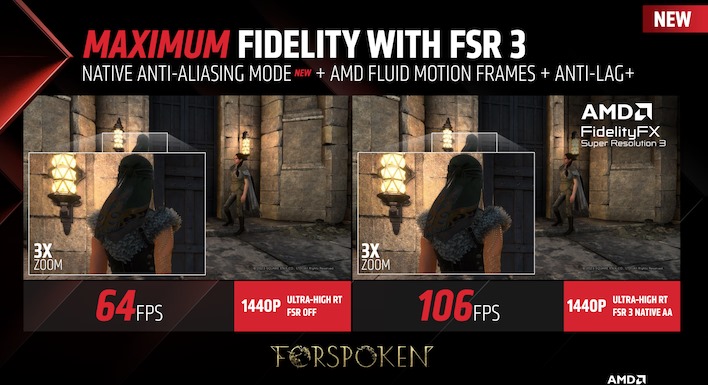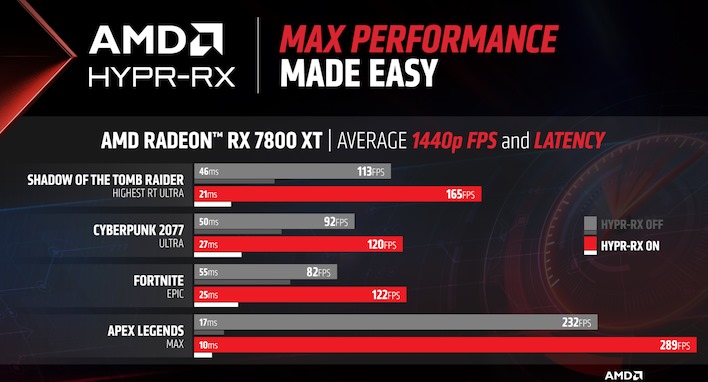AMD Unveils Radeon RX 7800 XT And RX 7700 XT To Battle GeForce In 1440p Gaming Dogfight
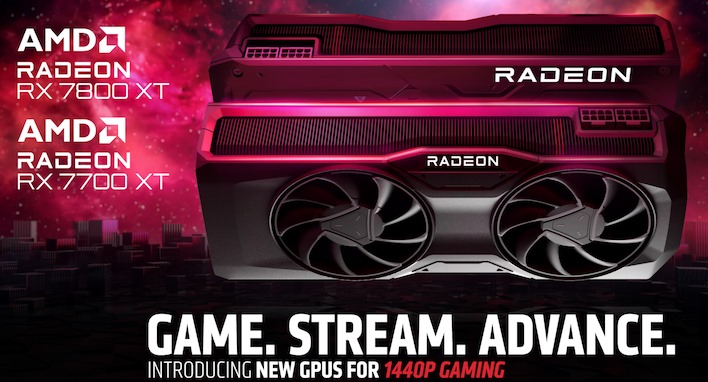
Surprise—exactly as rumored, AMD has just announced its mid-range RDNA 3 Radeon graphics cards. They've been a long time coming. The Radeon RX 7900 XTX and RX 7900 XT launched way back in December of last year, more than nine months ago at this point. For the one-tier-down GPUs to have taken this long is quite unusual, and we could speculate for hours as to why that might be, but we've already done that in our previous coverage.
Instead, let's focus on the parts as announced today. There's two different models: the Radeon RX 7800 XT, and the Radeon RX 7700 XT. The faster card will have an AMD reference model that looks pretty similar to the high-end RX 7900 cards. However, the RX 7700 XT will only come from AIB vendors. Depending on how you feel about AMD's reference coolers this generation, that could be a good thing.
Exactly as rumored, these parts are both based on the Navi 32 GPU. This part is extremely similar to the Navi 31 GPU that powers the top-end RX 7900 series GPUs, in that it shares the RDNA 3 architecture and that the GPU package consists of a large "GCD" processor surrounded by a few "MCD" chips that provide both cache and GDDR6 memory access to the GCD where all the processing actually happens.
In the case of these two parts, it looks like we're seeing a close mirror of the RX 7900 XT and RX 7900 XTX, just with the smaller Navi 32 package. What do we mean by that? Well, the RX 7800 XT is a fully-enabled Navi 32 part with 60 compute units and a 256-bit memory bus (utilizing four MCDs, totaling 64MB of Infinity Cache), and then the RX 7700 XT drops one MCD and 10% of its compute capacity to give it 54 compute units fed by a 192-bit memory bus and 48MB of Infinity Cache.

Prices based on current street prices at Amazon and other retailers.
The chop to memory bus width also means a reduction in memory capacity, of course, so the RX 7800 XT's 16 GB gets chopped to 12 GB on the RX 7700 XT. That's the same memory capacity as the last-generation RX 6700 XT, and it's also the same amount as NVIDIA applies to its current-generation "7"-tier cards.
We say that because AMD emphasizes that these GPUs are "the upgrade you waited for", showing benchmarks of current games running on the Radeon RX 5700 XT and RTX 2070 SUPER against the new GPUs. This is a fine demonstration, but we have to wonder if it isn't clearly the case that more PC gamers have 1080p 120Hz or 144Hz monitors as compared to 1440p monitors. Folks who are addicted to smooth motion (like me) would surely appreciate the high-refresh performance at lower resolution.
AMD presents numbers comparing the RX 7800 XT against the GeForce RTX 4070, where it comes out broadly ahead though falls behind a little in games making heavy use of ray-traced effects. We have to praise AMD's transparency here, as it would have been very easy for the company to cherry-pick its results to include ONLY the games that make its product look good. As it stands, the RX 7800 XT still comes out looking pretty good, especially considering that it apparently manages 60 or higher average FPS in every game listed.
AMD also compares the RX 7700 XT against the RTX 4060 Ti in its 16GB variation across the same swath of games. This is a more conclusive victory for AMD, although it's no secret that the RTX 4060 Ti's performance falls off quickly in higher resolutions. The wider memory bus of the RX 7700 XT allows it to run ahead in many of the games here, though its weaker ray-tracing performance means even a 50% bandwidth advantage can't save it in some of the titles. We also suspect AMD isn't testing Cyberpunk 2077 at truly "max settings"; that would imply path-tracing, which RDNA 3 isn't great at.
Besides the new GPUs, AMD's also announcing software upgrades. The long-awaited FidelityFX Super Resolution 3 is finally making its appearance, with AMD promising to take Forspoken from a meager 36 FPS in 4K "ultra-high RT" all the way up to 122 FPS using FSR 3 "Performance" mode. The company hasn't shared anything about how FSR 3 works, but from what we know (and based on the name "Fluid Motion Frames"), it appears to be a direct answer to NVIDIA's DLSS 3 Frame Generation.
Along with the Fluid Motion Frames feature, AMD's also debuting a new mode for FSR known as "Native AA mode." This essentially applies FidelityFX Super Resolution 2 without performing upscaling. In that sense, it's just like rival NVIDIA's DLAA technology, which uses DLSS as a form of temporal anti-aliasing. The same thing is happening here; AMD claims that using FSR Native AA with Fluid Motion Frames, an RX 7800 XT can take Forspoken in "Ultra-High" quality from 64 FPS up to 106 FPS, with an improvement in image quality.

Of course, fancy new software means nothing if developers don't implement it. Fortunately, AMD has piled up a decent little batch of developers willing to put FSR 3 in their games. Upcoming titles listed above include the Far Cry-like Avatar: Frontiers of Pandora, long-awaited Black Myth: Wukong, the gorgeous Crimson Desert, and Sega's next Like a Dragon game, subtitled "Infinite Wealth".

Corporate partners planning to use FSR 3, according to AMD, include Ubisoft, Sega, Bandai-Namco, Square-Enix, Focus Entertainment, CD Projekt Red, Ascendant Studios, Pearl Abyss, and the all-important Unreal Engine. FSR 3 support in Unreal Engine 5 could mean that the tech becomes widespread in the next generation of video games.
When AMD released the Radeon RX 7900 cards, it also announced an upcoming feature called HYPR-RX. Enthusiasts around the web had some fun picking at the name, but it wasn't exactly clear exactly what the feature would be. Well, AMD's better explained it now: it's a one-click toggle to enable AMD's Radeon Boost, Radeon Anti-Lag+, and Radeon Super Resolution features.
According to the GPU vendor, when you toggle on HYPR-RX, you both raise the performance and slash the input lag for your game. That's great, but what AMD isn't mentioning is that by enabling Radeon Super Resolution you are undoubtedly taking a hit to image quality. If you're playing on a high-DPI monitor, you may not actually notice the difference, but given that the performance uplifts AMD is promising take you from 80 or 90 FPS to 120, we're not really sure the slash to image quality is really worth it.
Naturally, AMD has to emphasize all of the latest livestreaming technologies that its GPUs support too. These include things like hardware AV1 video encoding and AI-powered noise suppression. AV1 video is a big deal, and YouTube supports it now; if you live-stream to YouTube and you're not using AV1, you're doing your viewers a disservice. Interestingly, AMD's noise suppression supports a toggle to run it on the CPU or on the GPU.
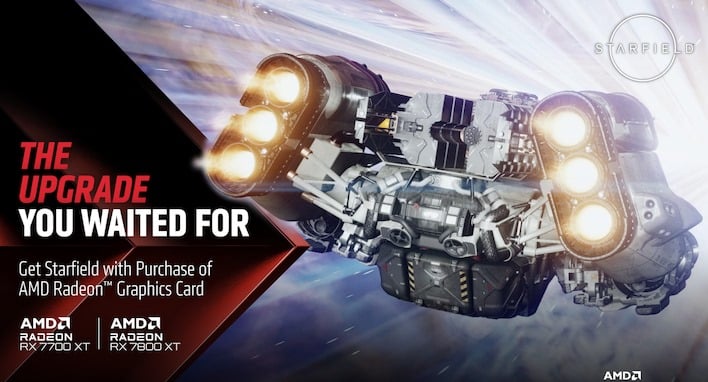
If all this news has you chomping at the bit for a new Radeon card, you don't have long to wait. AMD says that the parts will be available on September 6th. The Radeon RX 7800 XT will start at $499, while the Radeon RX 7700 XT will be $50 cheaper, starting at $449. At those prices, it might be hard to recommend the RX 7700 XT, once again much like the situation with the RX 7900 XT and XTX cards. We'll have to benchmark them to be sure, though. Look out for our full review sooner than later.


